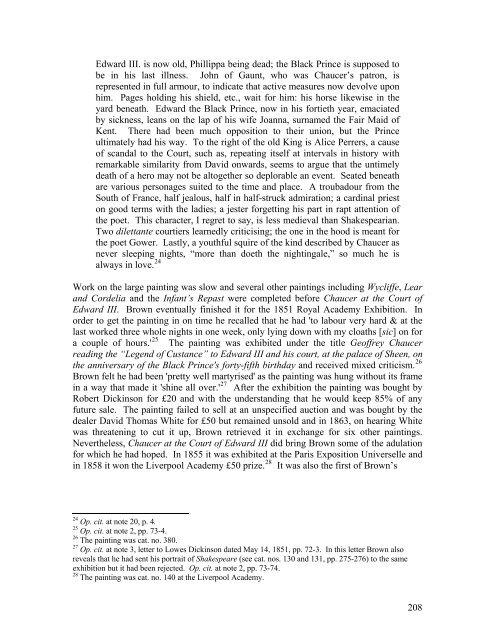ford madox brown - eTheses Repository - University of Birmingham
ford madox brown - eTheses Repository - University of Birmingham
ford madox brown - eTheses Repository - University of Birmingham
Create successful ePaper yourself
Turn your PDF publications into a flip-book with our unique Google optimized e-Paper software.
Edward III. is now old, Phillippa being dead; the Black Prince is supposed to<br />
be in his last illness. John <strong>of</strong> Gaunt, who was Chaucer’s patron, is<br />
represented in full armour, to indicate that active measures now devolve upon<br />
him. Pages holding his shield, etc., wait for him: his horse likewise in the<br />
yard beneath. Edward the Black Prince, now in his fortieth year, emaciated<br />
by sickness, leans on the lap <strong>of</strong> his wife Joanna, surnamed the Fair Maid <strong>of</strong><br />
Kent. There had been much opposition to their union, but<br />
the Prince<br />
ultimately had his way. To the right <strong>of</strong> the old King is Alice Perrers, a cause<br />
<strong>of</strong> scandal to the Court, such as, repeating itself at intervals in history with<br />
remarkable similarity from David onwards, seems to argue that the untimely<br />
death <strong>of</strong> a hero may not be altogether so deplorable an event. Seated beneath<br />
are various personages suited to the<br />
time and place. A troubadour from the<br />
South <strong>of</strong> France, half jealous, half in<br />
half-struck admiration; a cardinal priest<br />
on good terms with the ladies; a jester forgetting his part in rapt attention<br />
<strong>of</strong><br />
the poet. This character, I regret to say, is less medieval than Shakespearian.<br />
Two dilettante courtiers<br />
learnedly criticising; the one in the hood is meant for<br />
the poet Gower. Lastly, a youthful squire <strong>of</strong> the kind described by Chaucer as<br />
never sleeping nights, “more than doeth<br />
the nightingale,” so much he is<br />
24<br />
always in love.<br />
Work on the large painting was slow and several other paintings including Wycliffe, Lear<br />
and Cordelia and the Infant’s Repast were completed before Chaucer at the Court <strong>of</strong><br />
Edward III. Brown eventually finished it for the 1851 Royal Academy Exhibition. In<br />
order to get the painting in on time he recalled that he had 'to labour very hard & at the<br />
last worked three whole nights in one week, only lying down with my cloaths [sic] on for<br />
a couple <strong>of</strong> hours.'<br />
future sale. The painting failed to sell at an unspecified auction and was bought by the<br />
dealer David Thomas White for £50 but remained unsold and in 1863, on hearing White<br />
25 The painting was exhibited under the title Ge<strong>of</strong>frey Chaucer<br />
reading the “Legend <strong>of</strong> Custance” to Edward III and his court, at the palace <strong>of</strong> Sheen, on<br />
the anniversary <strong>of</strong> the Black Prince's forty-fifth birthday and received mixed criticism. 26<br />
Brown felt he had been 'pretty well martyrised' as the painting was hung without its frame<br />
in a way that made it 'shine all over.' 27 After the exhibition the painting was bought by<br />
Robert Dickinson for £20 and with the understanding that he would keep 85% <strong>of</strong> any<br />
was threatening to cut it up, Brown retrieved it in exchange for six other paintings.<br />
Nevertheless, Chaucer at the Court <strong>of</strong> Edward III did bring Brown some <strong>of</strong> the adulation<br />
for which he had hoped. In 1855 it was exhibited at the Paris Exposition Universelle and<br />
in 1858 it won the Liverpool Academy £50 prize. 28 It was also the first <strong>of</strong> Brown’s<br />
24<br />
Op. cit. at note 20, p. 4.<br />
25<br />
Op. cit. at note 2, pp. 73-4.<br />
26<br />
The painting was cat. no. 380.<br />
27<br />
Op. cit. at note 3, letter to Lowes Dickinson dated May 14, 1851, pp. 72-3. In this letter Brown also<br />
reveals that he had sent his portrait <strong>of</strong> Shakespeare (see cat. nos. 130 and 131, pp. 275-276) to the same<br />
exhibition but it had been rejected. Op. cit. at note 2, pp. 73-74.<br />
28<br />
The painting was cat.<br />
no. 140 at the Liverpool Academy.<br />
208

















